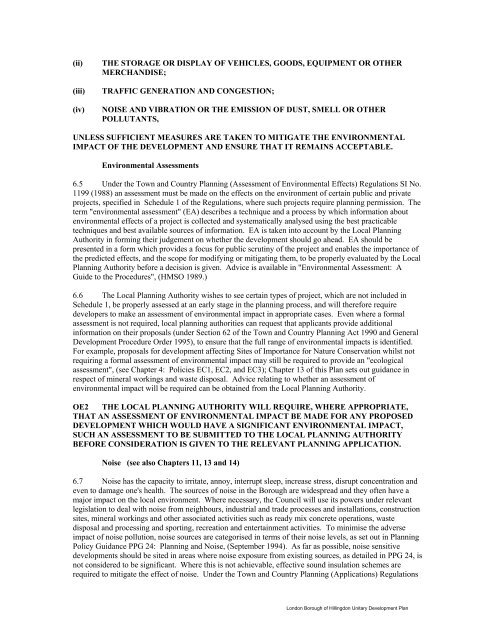HILLINGDON UNITARY DEVELOPMENT PLAN - London Borough ...
HILLINGDON UNITARY DEVELOPMENT PLAN - London Borough ...
HILLINGDON UNITARY DEVELOPMENT PLAN - London Borough ...
You also want an ePaper? Increase the reach of your titles
YUMPU automatically turns print PDFs into web optimized ePapers that Google loves.
(ii)<br />
(iii)<br />
(iv)<br />
THE STORAGE OR DISPLAY OF VEHICLES, GOODS, EQUIPMENT OR OTHER<br />
MERCHANDISE;<br />
TRAFFIC GENERATION AND CONGESTION;<br />
NOISE AND VIBRATION OR THE EMISSION OF DUST, SMELL OR OTHER<br />
POLLUTANTS,<br />
UNLESS SUFFICIENT MEASURES ARE TAKEN TO MITIGATE THE ENVIRONMENTAL<br />
IMPACT OF THE <strong>DEVELOPMENT</strong> AND ENSURE THAT IT REMAINS ACCEPTABLE.<br />
Environmental Assessments<br />
6.5 Under the Town and Country Planning (Assessment of Environmental Effects) Regulations SI No.<br />
1199 (1988) an assessment must be made on the effects on the environment of certain public and private<br />
projects, specified in Schedule 1 of the Regulations, where such projects require planning permission. The<br />
term "environmental assessment" (EA) describes a technique and a process by which information about<br />
environmental effects of a project is collected and systematically analysed using the best practicable<br />
techniques and best available sources of information. EA is taken into account by the Local Planning<br />
Authority in forming their judgement on whether the development should go ahead. EA should be<br />
presented in a form which provides a focus for public scrutiny of the project and enables the importance of<br />
the predicted effects, and the scope for modifying or mitigating them, to be properly evaluated by the Local<br />
Planning Authority before a decision is given. Advice is available in "Environmental Assessment: A<br />
Guide to the Procedures", (HMSO 1989.)<br />
6.6 The Local Planning Authority wishes to see certain types of project, which are not included in<br />
Schedule 1, be properly assessed at an early stage in the planning process, and will therefore require<br />
developers to make an assessment of environmental impact in appropriate cases. Even where a formal<br />
assessment is not required, local planning authorities can request that applicants provide additional<br />
information on their proposals (under Section 62 of the Town and Country Planning Act 1990 and General<br />
Development Procedure Order 1995), to ensure that the full range of environmental impacts is identified.<br />
For example, proposals for development affecting Sites of Importance for Nature Conservation whilst not<br />
requiring a formal assessment of environmental impact may still be required to provide an "ecological<br />
assessment", (see Chapter 4: Policies EC1, EC2, and EC3); Chapter 13 of this Plan sets out guidance in<br />
respect of mineral workings and waste disposal. Advice relating to whether an assessment of<br />
environmental impact will be required can be obtained from the Local Planning Authority.<br />
OE2 THE LOCAL <strong>PLAN</strong>NING AUTHORITY WILL REQUIRE, WHERE APPROPRIATE,<br />
THAT AN ASSESSMENT OF ENVIRONMENTAL IMPACT BE MADE FOR ANY PROPOSED<br />
<strong>DEVELOPMENT</strong> WHICH WOULD HAVE A SIGNIFICANT ENVIRONMENTAL IMPACT,<br />
SUCH AN ASSESSMENT TO BE SUBMITTED TO THE LOCAL <strong>PLAN</strong>NING AUTHORITY<br />
BEFORE CONSIDERATION IS GIVEN TO THE RELEVANT <strong>PLAN</strong>NING APPLICATION.<br />
Noise (see also Chapters 11, 13 and 14)<br />
6.7 Noise has the capacity to irritate, annoy, interrupt sleep, increase stress, disrupt concentration and<br />
even to damage one's health. The sources of noise in the <strong>Borough</strong> are widespread and they often have a<br />
major impact on the local environment. Where necessary, the Council will use its powers under relevant<br />
legislation to deal with noise from neighbours, industrial and trade processes and installations, construction<br />
sites, mineral workings and other associated activities such as ready mix concrete operations, waste<br />
disposal and processing and sporting, recreation and entertainment activities. To minimise the adverse<br />
impact of noise pollution, noise sources are categorised in terms of their noise levels, as set out in Planning<br />
Policy Guidance PPG 24: Planning and Noise, (September 1994). As far as possible, noise sensitive<br />
developments should be sited in areas where noise exposure from existing sources, as detailed in PPG 24, is<br />
not considered to be significant. Where this is not achievable, effective sound insulation schemes are<br />
required to mitigate the effect of noise. Under the Town and Country Planning (Applications) Regulations<br />
<strong>London</strong> <strong>Borough</strong> of Hillingdon Unitary Development Plan
















